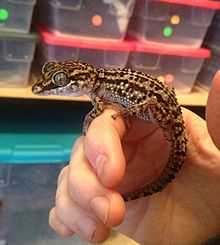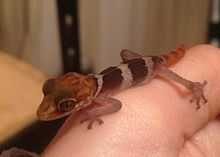Paroedura lohatsara
| Paroedura lohatsara | |
|---|---|
 | |
| Conservation status | |
| Scientific classification | |
| Kingdom: | Animalia |
| Phylum: | Chordata |
| Subphylum: | Vertebrata |
| Class: | Reptilia |
| Order: | Squamata |
| Family: | Gekkonidae |
| Genus: | Paroedura |
| Species: | P. lohatsara |
| Binomial name | |
| Paroedura lohatsara Glaw, Vences & Schmidt, 2001 | |
Paroedura lohatsara is a small-to-medium sized gecko native to northern Madagascar. This species is listed as critically endangered on the IUCN Red List,[2] but is not currently protected under CITES.[3]

Characteristics
P. lohatsara grow into their colors; as juveniles, they have brownish heads, black and white bands down their bodies, and a striped, orangey tail. As they mature, their coloration changes - the bands break up along their bodies, turning them into animals with a primarily light (yellowish) base color and black spotting. Oftentimes, the spotting will retain some semblance of striping, though it may tend to shift towards more lengthwise patterning. Adults of this species generally reach an approximate length of five to six inches.
While they are labeled as primarily terrestrial animals, they have been observed in the wild on boulders and branches up to two meters off the ground.[4] The pads of their toes allow them to adhere and climb to the sides of their terrariums in captivity, particularly as youngsters, though as their size and weight increases with age they seem to prefer foliage and other available areas for climbing. Both adults and juveniles are active at night, and this species is considered to be nocturnal.
Sexual maturity is reached at approximately one year of age; males display a hemipenal bulge near their vent, whereas females lack hemipenes and as such this bulge is absent.
In the Wild
This species is native to northern Madagascar, where it has been observed in Montagne des Francais between the elevations of 140 and 320 m asl.[4]
Conservation
This species is currently listed on the IUCN Red List as critically endangered.[4] It is not currently a protected species under CITES,[5] and is found in a reserve that is threatened significantly by human encroachment upon its natural habitat in the form of deforestation, primarily for logging.[4] In the US, there are a few known herpetologists who are working toward helping these animals reproduce in captivity to assist in creating a buffer zone between this animal's current population and their potential extinction. (See "In Captivity" section below)
In Captivity
As this species is so rare in the hobby of reptile keeping, not a great deal is known about their behaviors. Translated, the scientific name of 'Lohatsara' breaks up into two separate Malagasy words. "Loha" means head, and "tsara" loosely translates to good or beautiful. It is unknown how many of these are kept in captivity in the US, but they are not an extremely common captive. They are quickly becoming endangered in the wild.
References
- ↑ Raxworthy, C.J., Ratsoavina, F., Rabibisoa, N., Rakotondrazafy, N.A. & Bora, P. 2011. Paroedura lohatsara. In: IUCN 2013. IUCN Red List of Threatened Species. Version 2013.1. <www.iucnredlist.org>. Downloaded on 13 July 2013.
- ↑ http://www.iucnredlist.org/
- ↑ http://www.cites.org/eng/resources/species.html
- ↑ 4.0 4.1 4.2 4.3 http://www.iucnredlist.org/details/172898/0
- ↑ http://www.cites.org/
